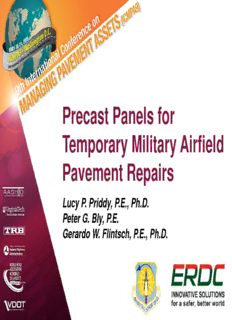
Precast Panels for Temporary Military Airfield Pavement Repairs PDF
Preview Precast Panels for Temporary Military Airfield Pavement Repairs
Precast Panels for Temporary Military Airfield Pavement Repairs Lucy P. Priddy, P.E., Ph.D. Peter G. Bly, P.E. Gerardo W. Flintsch, P.E., Ph.D. Problem Statement Expedient military repair methods are required for concrete airfield pavements Emergency repair operations do not allow for long closures Traditional PCC requires time to gain strength Proprietary repair materials are costly and a logistical burden Solution: precast PCC technology? 2 Objective Develop expedient precast panel repair system for military repair teams Possible Damage Spectrum 3 System Design Challenges The system must: • Support 3,000 C-17 passes • Be completed within 4-6 hr • Enable local material use • Allow various repair sizes • Require limited specialty equipment • Rely upon simplified techniques/procedures • Require minimal training • Be readily deployable 4 Previous Investigations • Periodic investigations for past 50-80 years • Pre-2000s • Initially focused on airfield pavements • Many concepts evaluated worldwide • Primarily focused on highway investigations • Many technical feasibility studies • Recent investigations • Renewed precast panel research and interest • Primarily focused on highway applications • State, national, and international studies • Limited commercial airfield usage • Limited performance documentation 5 Selected Precast System Prototype Panel Air Force Method Prototype • Designed for airfield use Dowel Slots • Supported simulated F-15 traffic Panel • Similar to other generic systems in load transfer mechanisms F-15 Load Cart • Cost similar to proprietary repair matls. • Cost similar to other precast systems Panel Dowel Slots 6 Drawbacks to the Selected System • Small precast panel size (10 ft x 10 ft repair) • Inability to connect panels • No minimum panel lifting capabilities • No documentation for reinforcement design • Lack of repair timing data/work tasks • Lack of performance data under aircraft traffic 7 Research Approach Optimize Analyze panel Results designs Conduct Conduct Traffic Repairs Tests 8 New Panel Designs 9 Test Section Cross Section 3 in. Flowable Fill 14 in. 11 in. 11 in. 11 in. 11 in. 14 in. PCC Panel Panel Panel Panel PCC 6 in. Crushed Stone Base (eff k=276 pci) Compacted Subgrade •Pavem ent designed to support 50,000 C-17 passes at 580,000 lb (PCASE) •Subgrade soil classification of CL; base course classification of GW •1% (1 ft) longitudinal slope and 0.5% (0.3 ft) cross slope for drainage •Test Section PCC UCS 7,240 psi (ASTM C39) •Precast PCC UCS 5,710 psi (ASTM C39) 10
Description: